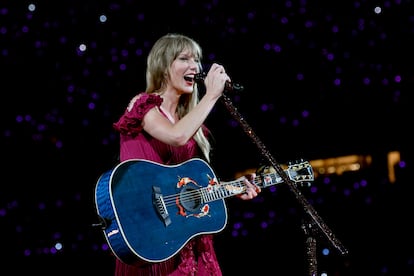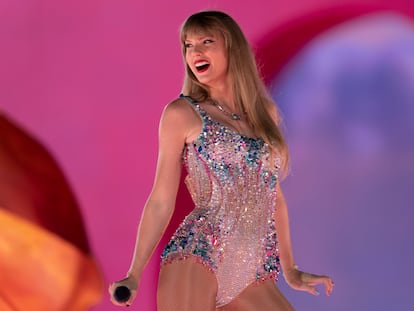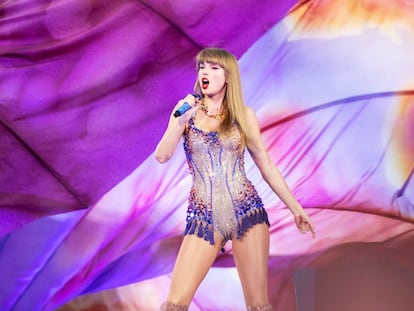Civil war between Taylor Swift fans: Gaylors vs Hetlors
A toxic dispute about the singer’s sexual orientation divides her followers

Taylor Swift’s recent release of When Emma Falls in Love, a song she wrote in 2010, has reignited a long-standing and somewhat laughable controversy between two major factions of the Pennsylvania-born singer-songwriter’s fan base. The majority faction sees the ballad as a reflection on the past relationship between Andrew Garfield and Emma Stone, Swift’s close friend. But the minority faction believes it to be a delayed acknowledgment of something they long suspected — that Taylor and Emma once had a romantic relationship.
It all started on Tumblr around 2014. Taylor Swift was 25 years old at the time and had just released her fifth album, 1989. In a twist of fate, Swift had her first encounter with the Gaylors. A small but mighty group of LGBTQI+ fans, they flocked together under the #Gaylor hashtag in the digital realms of Tumblr (which soon expanded to Twitter). Even in those early days, the Gaylors passionately argued that Taylor’s true love lay with women, that she was hidden deep in the closet for fear of societal judgment and the homophobic strictures of the entertainment industry. Over the years, they connected Swift to romantic entanglements with models and actresses like Karlie Kloss, Cara Delevingne and Hailee Steinfeld. The Gaylors pointed to unequivocally lesbian undertones in songs like The Very First Night, Welcome to New York, Style and I Wish You Would. On the surface, these tracks may appear to be simple heteronormative love songs, but when viewed through queer lenses, they shimmer with shades of pink and purple. Swift herself unintentionally stoked the fires of this theory when she revealed in 2019 that her lyrics were subtly infused with hidden messages, and that her most enigmatic songs were also the most heartfelt.
In 2022, the #Gaylor wave swept over social media. Celebrities like Jennifer Lawrence helped spread the controversial hashtag, which has now become the main thread of a mesmerizing soap opera. Champions of the movement, like the Gaylor Updates Twitter account, excitedly projected that Gaylors made up at least a fifth of the ever-expanding Swifties community. “Little by little, the truth comes out” is their slogan. In 2022, a new and dark force emerged — the Hetlors. At first, they simply called for common sense (because, let’s be real, there’s no evidence of Swift being anything but herself). However, things quickly took a turn as they clashed with the Gaylors in increasingly intolerant and aggressive disputes.
Swift’s Eras tour through the United States has shifted the battleground away from social media to the stadiums where she performs. In May, she publicly announced her breakup with Joe Alwyn, the latest of her official paramours. The Gaylors saw it as the perfect moment to ramp up their offensive and made a bold attempt to drag her out of the closet. Chanting slogans and waving signs at the concerts, they created one of the most attention-grabbing spectacles in the history of popular music. But they weren’t prepared for the fierce backlash from the Hetlors. This sparked a string of ugly, awkward incidents at shows in Glendale, Tampa, Nashville, Philadelphia and Las Vegas, with passionate fans trying to pull the pop icon into their own realm, believing they have the right to claim ownership of her private life.
Cristina López and Avneesh Chandra, authors of a fascinating study on the subject for the Graphika Reports website, wrote that the Swiftie sub-communities have become increasingly polarized under mainstream attention. “As the divide has deepened, these groups have engaged in doxxing, coordinated harassment, and online intimidation to silence opposing views.” The Gaylors are viewed as “consensus disruptors” and face strong disapproval from the majority group. According to their analysis of social media activity, the Gaylors constitute only 9% of the Swiftie community. Meanwhile, anti-Gaylor proponents now make up over 28% of the community, and also have the support of many presumably impartial fans.
The online guerrilla tactics of misinformation and digital lynchings have turned Taylor Swift’s digital fandom into a toxic environment, while she remains silent and struggles to find a constructive way to mediate between her passionate followers. The next challenge will be her international tour, starting in August at the Foro Sol Stadium in Mexico City and ending in Madrid on May 30, 2024.
Sign up for our weekly newsletter to get more English-language news coverage from EL PAÍS USA Edition
Tu suscripción se está usando en otro dispositivo
¿Quieres añadir otro usuario a tu suscripción?
Si continúas leyendo en este dispositivo, no se podrá leer en el otro.
FlechaTu suscripción se está usando en otro dispositivo y solo puedes acceder a EL PAÍS desde un dispositivo a la vez.
Si quieres compartir tu cuenta, cambia tu suscripción a la modalidad Premium, así podrás añadir otro usuario. Cada uno accederá con su propia cuenta de email, lo que os permitirá personalizar vuestra experiencia en EL PAÍS.
¿Tienes una suscripción de empresa? Accede aquí para contratar más cuentas.
En el caso de no saber quién está usando tu cuenta, te recomendamos cambiar tu contraseña aquí.
Si decides continuar compartiendo tu cuenta, este mensaje se mostrará en tu dispositivo y en el de la otra persona que está usando tu cuenta de forma indefinida, afectando a tu experiencia de lectura. Puedes consultar aquí los términos y condiciones de la suscripción digital.
More information
Archived In
Últimas noticias
Maduro pleads not guilty before the federal court in New York: ‘I am still the president of Venezuela’
A new test can detect Alzheimer’s from a finger prick
UN team enters Sudanese city of El Fasher after paramilitary massacre: ‘It’s like a ghost town’
A recipe for resistance: Indigenous peoples politicize their struggles from the kitchen
Most viewed
- Gilles Lipovetsky: ‘If you want to live better and fall in love, take Prozac, don’t look to philosophy’
- Alain Aspect, Nobel laureate in physics: ‘Einstein was so smart that he would have had to recognize quantum entanglement’
- Alvin Hellerstein, a 92-year-old judge appointed by Bill Clinton, to preside over Maduro’s trial in New York
- Why oil has been at the center of Venezuela-US conflicts for decades
- Maduro’s downfall puts China’s relationship with Venezuela to the test











































